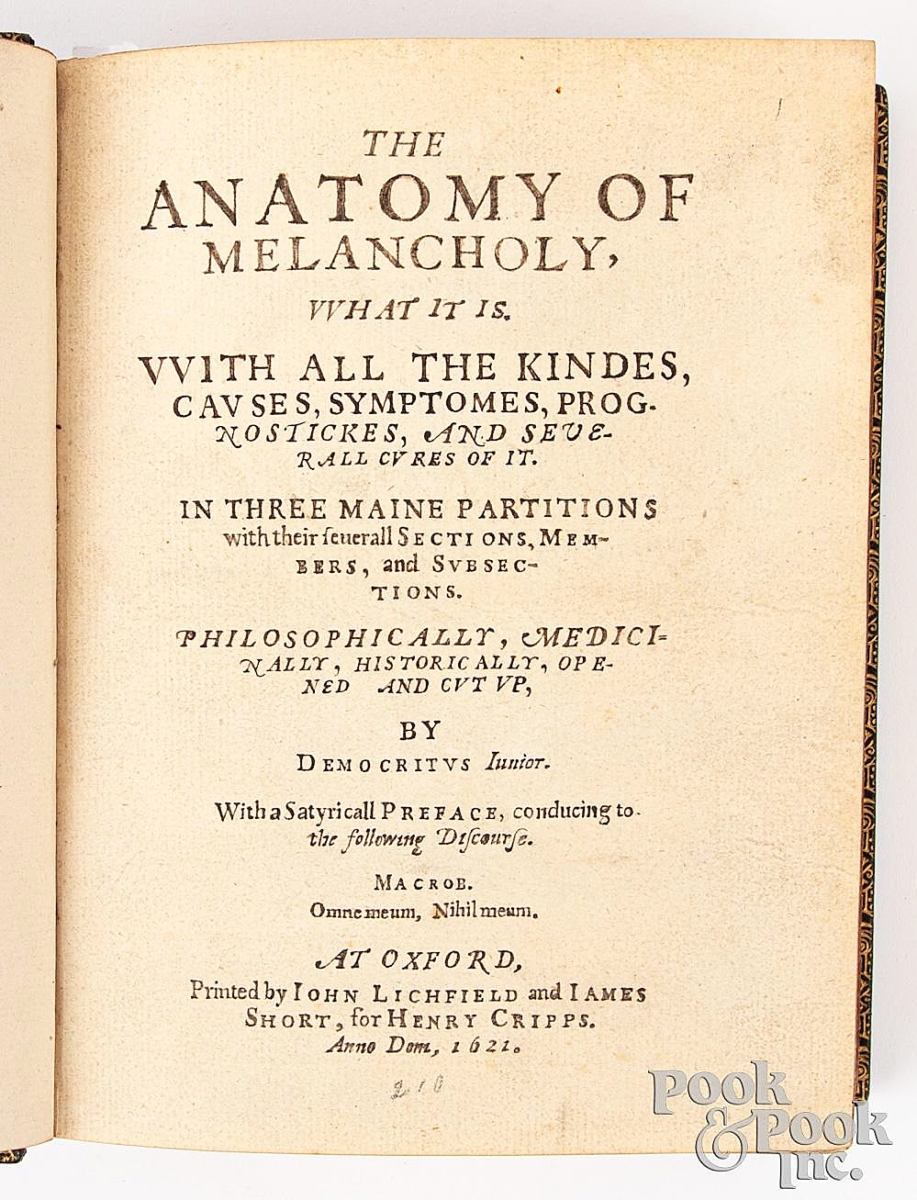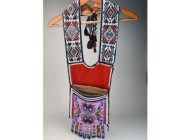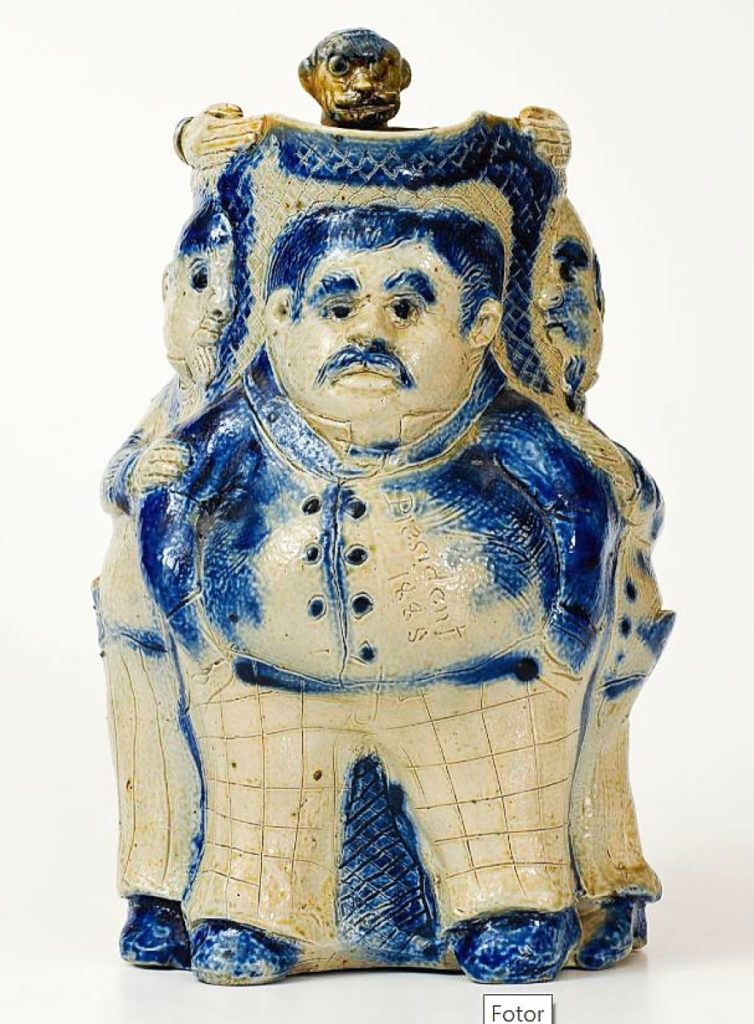
Topping the sale was this cobalt-decorated stoneware Grover Cleveland pitcher, signed and dated “Anna Pottery / January 15, 1885,” selling for $120,000, more than double its high estimate. By Wallace and Cornwall Kirkpatrick, Anna, Ill., the wheel-thrown, ovoid-bodied pitcher with wide pouring spout was more than just an extravagantly decorated and sculpted figure of President Grover Cleveland. In quintessential Anna social commentary, Cleveland is flanked by three other figures representing American political corruption that stems from money buying power.
Review by W.A. Demers, Photos Courtesy Crocker Farm
SPARKS, MD. – It is customary at Crocker Farm auctions for the first lot across the block to provide the sale’s fireworks, and that was again the case with the firm’s online-only summer stoneware sale running from July 22 to August 5 when the auction closed with Lot 1, a highly important cobalt-decorated stoneware Grover Cleveland pitcher, signed and dated “Anna Pottery / January 15, 1885,” selling for $120,000 to a Pennsylvania collector, more than doubling its high estimate. By Wallace and Cornwall Kirkpatrick, Anna, Ill, the wheel-thrown, ovoid-bodied pitcher with wide pouring spout was extravagantly decorated around the body with a sculpted figure of President Grover Cleveland flanked by three other figures. Cleveland assumes a confident pose with coiffed hair and hands tucked in his pockets, wearing a double-breasted suit and checkered pants, his chest emblazoned with the incised title, “President / 1885.”
As with most Anna figures, the message behind the figure is clearly social commentary. Two goateed figures flanking the president grab his shoulder and whisper in his ear, one with open jacket pocket, inscribed “Change,” the other also with jacket pocket opened and inscribed “Reform.” Both images follow the Kirkpatricks’ oft-repeated commentary on American political corruption and the idea of money buying power. A fourth, subtly smiling goateed figure with hands plunged deep in his pockets appears on the reverse. Acquired by the New England consignor from a Kirkpatrick family descendant in 1985, the figure stood 11¾ inches high. “I thought the $100,000-plus was a strong price,” said Mark Zipp. “Whenever you hit that six-figure price with American stoneware, it’s pretty special. It wasn’t until about 2011 that one or two pieces of salt-glazed stoneware hit that. There have been a bunch since then.”
The sale totaled $1,346,370 with just two lots of the 444 that were offered failing to find buyers, resulting in a 99.5 percent sell-through rate. Registered bidders numbered 511, participating through the firm’s own online bidding platform. There are two weeks of bidding and then a phone bidding session for items valued at $5,000 or more. “The market is so strong right now,” observed Zipp. “It seems hotter than ever. People really appreciate this American art form.”
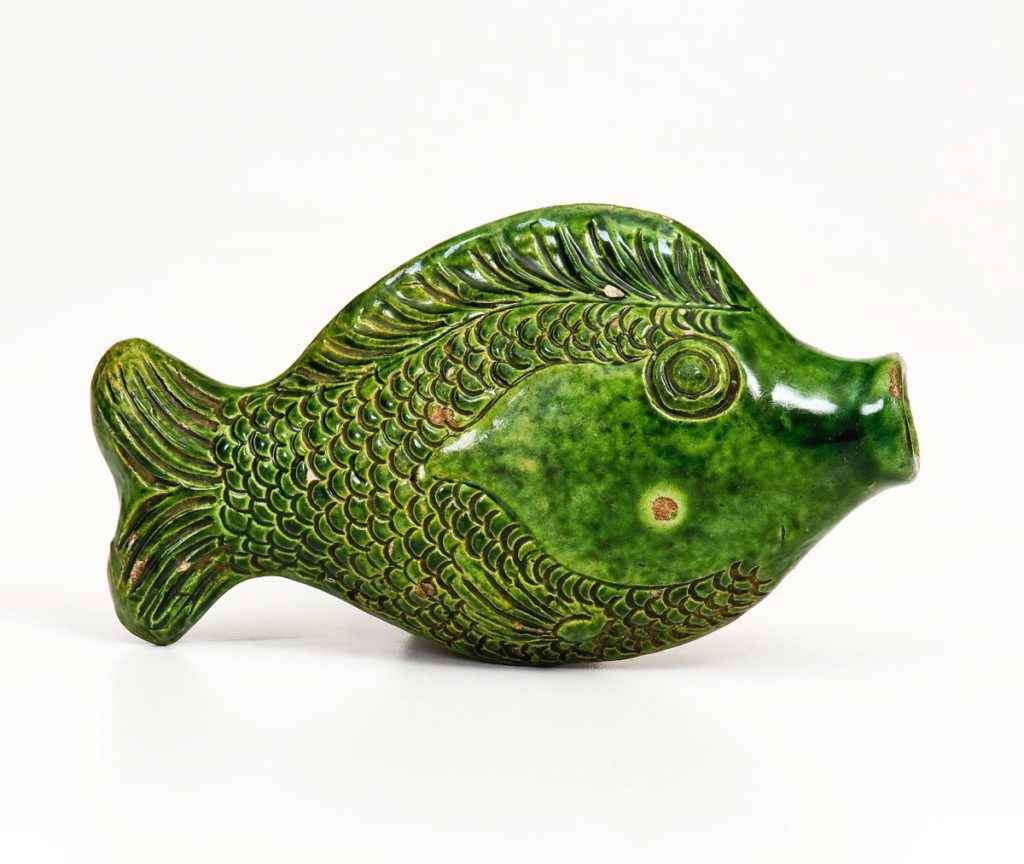
They don’t make them smaller than this. Molded in the smallest size for this form, just 4½ inches, this rare redware fish bottle with copper glaze of Salem, N.C., origin, circa 1801-29, brought $30,000.
Another runaway lot, although tranquil in subject, was a 4-gallon stoneware jar with an extravagant cobalt deer scene, stamped “J.&E. Norton / Bennington, Vt,” circa 1855. It finished at $96,000, a significant premium over the $10/20,000 valuation. The cylindrical jar with tooled shoulder, semi-rounded rim and applied lug handles was decorated with an extensive slip-trailed pastoral scene featuring a reclining spotted stag, large tree and a series of houses. The auction house in its catalog notes credited the 14½-inch-high jar with “displaying superb color and astonishing coverage of the design over the vessel’s front – even extending onto the piece’s right side – this work ranks among the most heavily decorated Norton stoneware jars known.”
“Exceptional design,” noted Zipp. “It had condition issues but those did not seem to matter because of the quality of the design. People are caring less and less about condition on the better pieces.”
Going out at ten times its high estimate at $60,000, a record for the maker, was an A.O. Whittemore/Havana, N.Y., 3-gallon stoneware fish crock with handles, decorated with a slip-trailed design of a large fish. According to catalog notes, this 10-inch-high crock was famously featured on the business card of renowned Saratoga Springs, N.Y., stoneware dealer and collector Willard Grande. It was purchased by the consignor from Grande in 2002. “Two people really wanted it,” said Zipp. “One was a Maryland collector and the other was a New York state collector. They were duking it out. Actually it ended up selling to a Pennsylvania collector.”
Stoneware by the enslaved Nineteenth Century potter David Drake commands big prices, and in this sale a rare 4-gallon alkaline-glazed stoneware jug, incised “June 13, 1855 / Dave / LM,” quadrupled its high estimate to sell for $48,000. “That was an exceptionally strong price,” said Zipp The LM stands for Lewis Miles’s Stony Bluff Manufactory, Horse Creek Valley, Edgefield District, S.C, This highly ovoid jug, 15-3/8 inches high, was evidently doubly-dipped upside-down in its glaze, the catalog noted, with the bottom one-to-two-thirds of the jug receiving the second application. Small, flame-like runs are visible below the maker’s mark and elsewhere around the jug’s circumference, created by this inverted double dipping. In addition, Drake’s fingerprints, or those of another potter responsible for glazing the jug, are visible at the base. As new discoveries of Drake’s work become fewer and fewer, examples like this jug with the desirable combination of Drake’s signature, Miles’s initials and its date of manufacture make it a remarkable recent discovery, having surfaced in Georgia by a couple of antiques dealers.
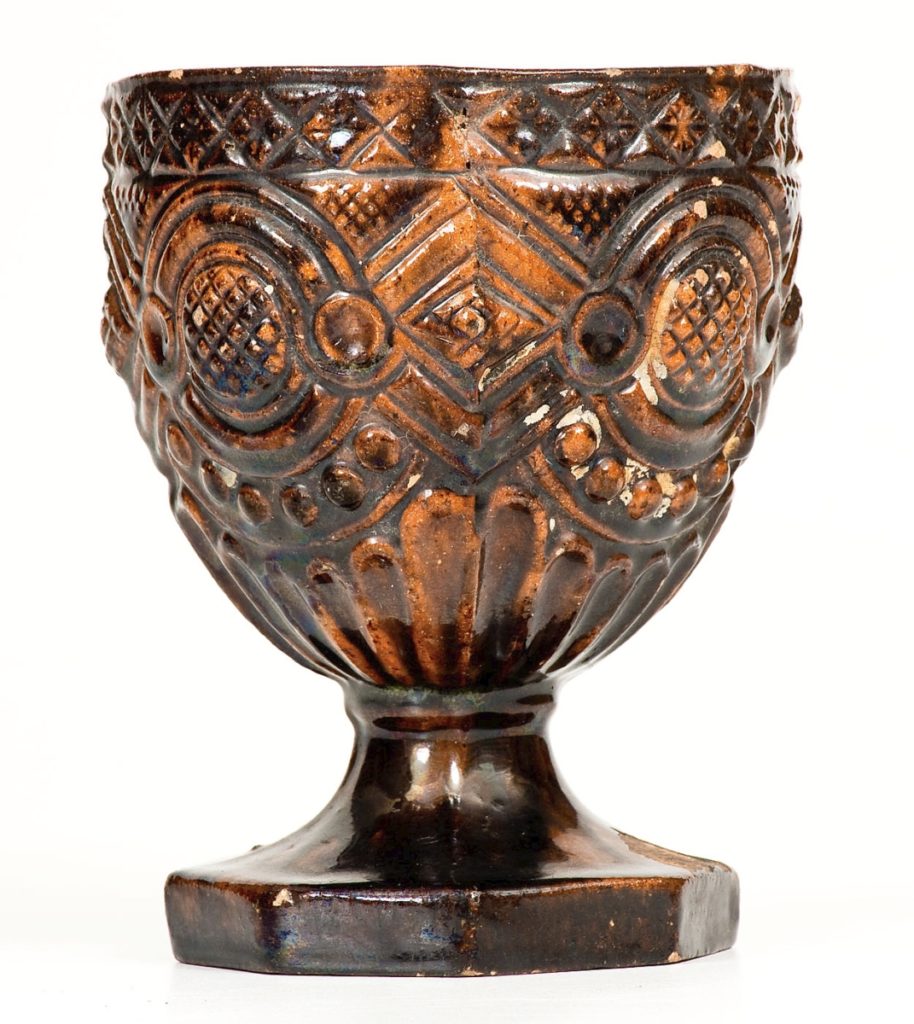
Bidders liked this molded, goblet-form flowerpot with relief geometric designs, pushing it to $24,000, six times its high estimate.
Fetching a bit less, $45,000, was a rare, large figure of a reclining deer with cobalt decoration. Its origin was deemed to be Ohio or western Pennsylvania, circa 1875, and it featured a hand-modeled figure of a deer with large antlers, bulging circular eyes and open mouth with carved teeth, reclining on a slab base with incised and cobalt-highlighted border. At a length of 14 inches and a height of 11-3/8 inches, the deer is among the largest surviving examples of Nineteenth Century American figural stoneware; in fact, it set a world auction record in 2007 for an American folk pottery sculpture.
Mixed-race African American potter James Madison Bussel (usually “Bussell” in written histories) was represented in the sale by an alkaline-glazed stoneware presentation pitcher that was bid to $36,000. Inscribed “Present For Pleasant Grove / Made By J.M. Bussel / August 9th 1872,” it was a thin-walled, ovoid-bodied pitcher with upswept spout and a rare double-strap handle with flattened thumb rest. Its surface was profusely decorated from rim to base with incised horizontal banding, around the collar with heavy incised slashes and throughout with impressed circular, semicircular and incised line decoration. Three circular stamps, each composed of different geometric elements – ellipses, small circles, and square-like impressions – were accompanied by a fourth, C-shaped stamp used in an opposing manner around the bottom half of the pitcher, connected in pairs by long, hand-incised diagonal lines. Bussel made it as a presentation piece for Pleasant Grove, likely Pleasant Grove Baptist Church, located near Bussel’s pottery in Washington County, Ga. It measured a relatively large 2 gallons and was 15 inches tall.
There was a run of three items, each realizing $34,800. The first was a rare glazed redware flowerpot, 8½ inches high, with applied bird-on-flower decorations, attributed to Absalom Bixler, Earl Township, Lancaster County, Penn., circa 1850, a flaring pot with semi-rounded rim, decorated on the front and reverse with hand-modeled and applied clay bird-on-flower motifs. The second was a rare 2-gallon stoneware jug with elaborate slip-trailed rooster decoration, stamped “Harrisburg, Pa,” John Young & Co., circa 1856-1858, a wonderful folk art rendering of a rooster, executed in slip-trailed cobalt. And finding a new home was a redware tea canister, probably southeastern Pennsylvania, late Eighteenth/early Nineteenth Century.
A 5-gallon cylindrical stoneware jug with a large cobalt feeding squirrel decoration made $32,400. It had a New York state origin, probably Fort Edward, circa 1875. While squirrels are plentiful in New York, they constitute a rare subject in Nineteenth Century American stoneware. This rendering of the animal is among the largest known figural designs in Nineteenth Century American stoneware, said Crocker Farm, with the squirrel itself measuring an imposing 14½ inches tall by 13 inches wide.
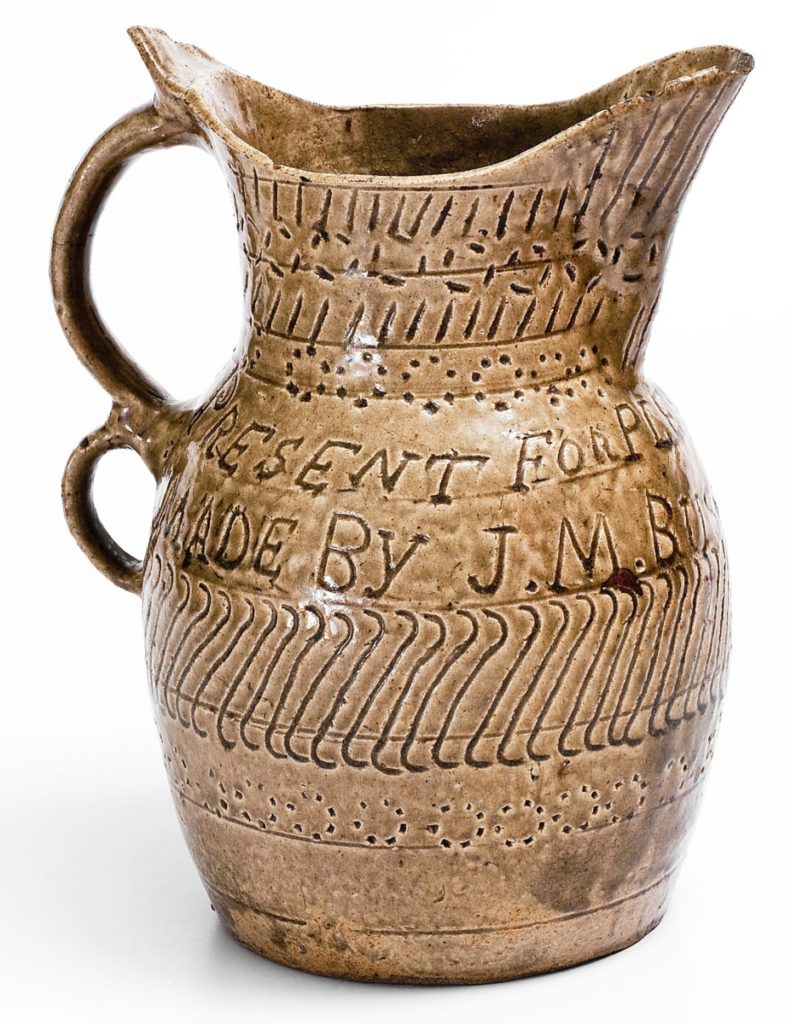
By African American potter James Madison Bussel, this alkaline-glazed stoneware presentation pitcher was inscribed “Present For Pleasant Grove / Made By J.M. Bussel / August 9th 1872,” and was bid to $36,000.
Speaking of squirrels, at $31,200 a copper-glazed redware squirrel bottle of Salem, N.C., origin, 1801-1829, was among the finest examples of this iconic Southern form known. Molded in the form of a standing squirrel feeding on a nut atop an oval base, the 7¾-inch-high piece featured an exceptional lime-green coloration to the glaze and had once been in the collection of the Stradlings.
A rare stoneware presentation face pitcher, 9 inches high and impressed “Sloop Orange” and “T. Crafts & Co. / Nashua,” took $30,000. It was produced by Martin Crafts, Nashua, N.H., circa 1840, was of ovoid shape with a tooled collar, and was decorated with a hand-modeled and sculpted clay face. There were not many face vessels produced in the New England potting tradition, and this work survives as one of a few signed American ceramic face vessels from the Nineteenth Century. Catalog notes surmise that the name “Sloop Orange” suggests the pitcher was made for use at sea, with the face possibly representing a sea captain.
Also bringing $30,000 was a rare small-sized redware fish bottle with copper glaze of Salem, N.C., origin, circa 1801-1829. With a surface covered in a mottled green lead-and-copper glaze, at 4½ inches long this was molded in the smallest size known for this form. “Any Southern redware is very popular right now” observed Zipp, “especially that from North Carolina. We’ve noticed in the past few sales that Moravian pieces are bringing exceptional prices.”
Rounding out the top highlights were a rare 4-gallon stoneware churn with cobalt songbird on flower decoration, stamped “John Burger / Rochester,” New York state origin, circa 1860, which left the gallery at $27,600; a rare glazed redware flowerpot attributed to Heinrich Schaffner, Salem, N.C., circa 1860, a molded, goblet-form flowerpot with relief geometric designs, including crosshatched circles and diamonds, which earned $24,000, six times its high estimate; and, bringing $19,200, more than triple its high estimate, a 3-gallon stoneware jar with impressed drape-and-heart motif, stamped “David Morgan / New York,” Manhattan, N.Y., origin, circa 1800, an ovoid jar with footed base, tooled shoulder and open loop handles, elaborately decorated on the front and reverse with impressed and cobalt-highlighted drape and heart-shaped tassel motifs, 13 inches high.
Prices given include the buyer’s premium as stated by the auction house. The next sale is now scheduled for November 4-18.
For additional information, www.crockerfarm.com or 410-472-2016.













